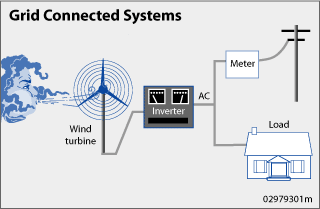grid-connected small wind electric system

Small wind energy systems can be connected to the electricity distribution system. These are called grid-connected systems.
A grid-connected wind turbine can reduce your consumption of utility-supplied electricity for lighting, appliances, and electric heat. If the turbine cannot deliver the amount of energy you need, the utility makes up the difference. When the wind system produces more electricity than the household requires, the excess is sent or sold to the utility.
With this type of grid-connection, note that the wind turbine will operate only when the utility grid is available. During power outages, the wind turbine is required to shut down due to safety concerns.
Grid-connected systems can be practical if the following conditions exist:
In the United States, federal regulations (specifically, the Public Utility Regulatory Policies Act of 1978, or PURPA) require utilities to connect with and purchase power from small wind energy systems. However, you should contact your utility before connecting to its distribution lines to address any power quality and safety concerns.
Your utility can provide you with a list of requirements for connecting your system to the grid.
